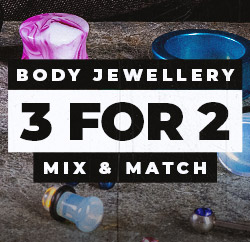Your new ear piercing has been performed in a sterile environment using high quality, sterile equipment and using a disposable, single use needle. It is now up to you to look after it to ensure it remains clean. Providing you follow our ear piercing aftercare guidelines you should experience little or no problems.
However, if you ever experience any issues or have any questions please feel free to return to store to see one of our piercers.
You can download your Ear Piercing Aftercare Guide here.
Ear piercings will require a lot of care, attention and patience from you, especially the cartilage areas. Ears are unfortunately very prone to being knocked about, slept on and exposed to the elements, all of which can prolong the healing process. The healing time for a cartilage piercing can therefore range from 6 to 18 months. Lobes however will usually heal fully in around 3 months.
To clean your new piercing you must use a solution of natural sea salt and pre-boiled water (a small pinch of salt in an egg cup of water is ideal). Using the salt water and a cotton bud gently clean the area twice a day. Tea tree oil (available in store) may also be used as a cleaning aid, simply apply to the skin 5 minutes prior to cleaning and wash off fully using the salt water. We recommend cleaning cartilage piercings twice a day for at least 10 weeks and lobes for 6 weeks.
The jewellery can usually be changed a few weeks after you have completed the cleaning regime. Do not twist or move your jewellery unnecessarily and never remove the jewellery before it is due to be changed. Also, keep any beauty products (makeup, fake tan etc) away from the area until it is fully healed.
Ears can unfortunately be prone to keloid scarring. This is your body simply healing over the area. Keloids usually look like a small red lump or spot around your piercing. If you should ever experience a keloid simply return to store to see a piercer and they will advise you on the best course of action.
As with any new piercing a local area of redness and a small amount of white/yellowish discharge are both healthy and completely normal. If you experience a more painful swelling, spread over a bigger area or accompanied by other symptoms of infection you should return to store and/or consult your GP. If your GP identifies an infection we recommend you ask them to check for Pseudomonas, although this is extremely rare it requires specialist antibiotics which some GPâs may not be experienced with.
Again, if you are ever concerned or have any questions please come back in to store for a chat. If you are unable to return to store for any reason please only consult a medical professional or visit our FAQ where we have extensive piercing information available for you to view.
Ear Piercing Aftercare: Cleaning & Healing Information
Ear piercings will require a lot of care, attention and patience from you, especially the cartilage areas. Ears are unfortunately very prone to being knocked about, slept on and exposed to the elements, all of which can prolong the healing process. The healing time for a cartilage piercing can therefore range from 6 to 18 months. Lobes however will usually heal fully in around 3 months.
To clean your new piercing you must use a solution of natural sea salt and pre-boiled water (a small pinch of salt in an egg cup of water is ideal). Using the salt water and a cotton bud gently clean the area twice a day. Tea tree oil (available in store) may also be used as a cleaning aid, simply apply to the skin 5 minutes prior to cleaning and wash off fully using the salt water. We recommend cleaning cartilage piercings twice a day for at least 10 weeks and lobes for 6 weeks.
The jewellery can usually be changed a few weeks after you have completed the cleaning regime. Do not twist or move your jewellery unnecessarily and never remove the jewellery before it is due to be changed. Also, keep any beauty products (makeup, fake tan etc) away from the area until it is fully healed.
Ears can unfortunately be prone to keloid scarring. This is your body simply healing over the area. Keloids usually look like a small red lump or spot around your piercing. If you should ever experience a keloid simply return to store to see a piercer and they will advise you on the best course of action.
As with any new piercing a local area of redness and a small amount of white/yellowish discharge are both healthy and completely normal. If you experience a more painful swelling, spread over a bigger area or accompanied by other symptoms of infection you should return to store and/or consult your GP. If your GP identifies an infection we recommend you ask them to check for Pseudomonas, although this is extremely rare it requires specialist antibiotics which some GPâs may not be experienced with.
Again, if you are ever concerned or have any questions please come back in to store for a chat. If you are unable to return to store for any reason please only consult a medical professional or visit our FAQ where we have extensive piercing information available for you to view.








